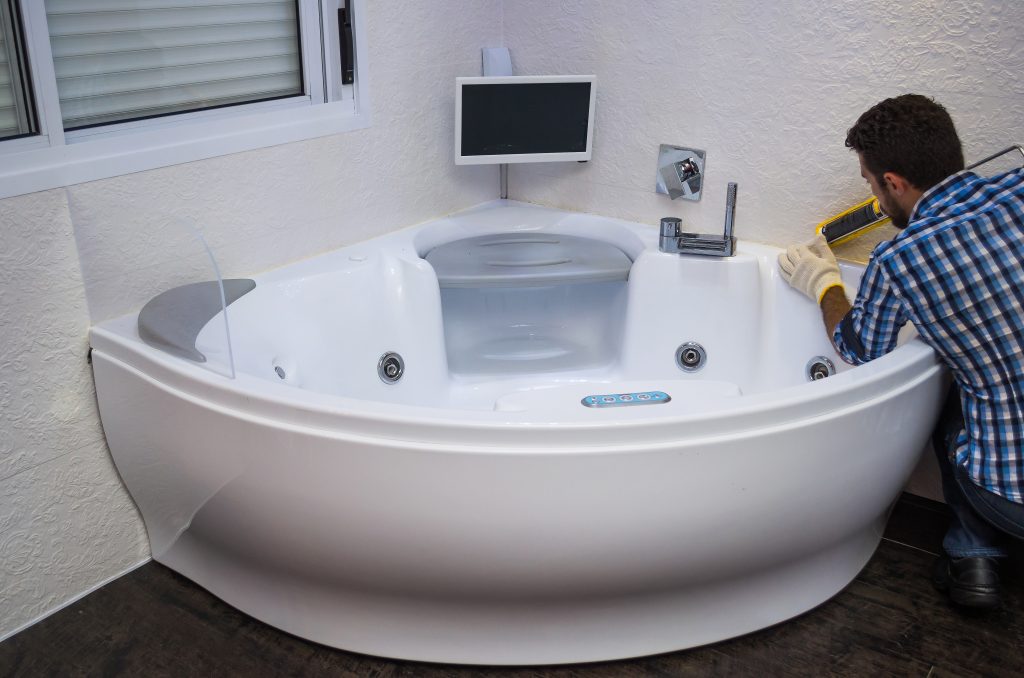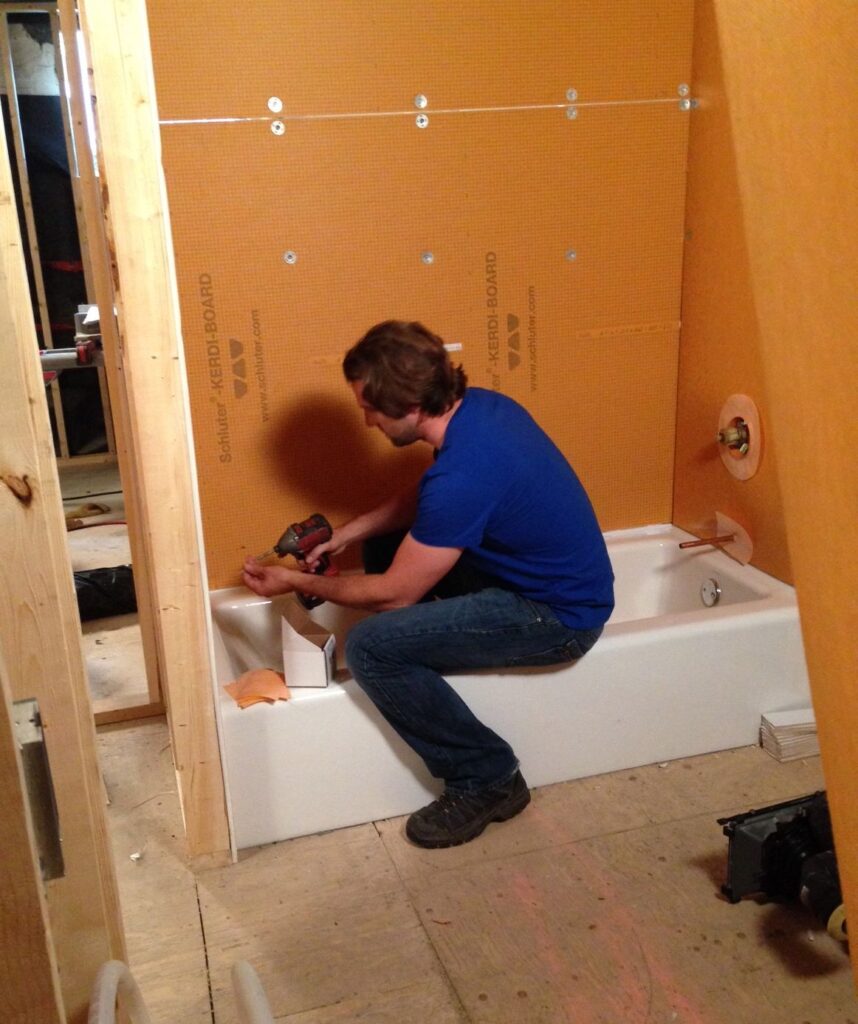Just How to Replace a Bathtub Yourself: Removing and also Replacing.
Just How to Replace a Bathtub Yourself: Removing and also Replacing.
Blog Article
The article author is making a few good pointers related to Installing A Bathtub in general in the content directly below.

Setting up a bathtub isn't precisely rocket science, yet it does need strong plumbing, woodworking, and often, tiling skills. Changing an old tub with a brand-new one is likewise a reasonably tough project. If the old tub is conveniently available, the task can move easily; if you have to open up a wall to get rid of the old tub and also position the brand-new bathtub, the task is a lot harder. In either case, the job is within a home handyman's skills, although you will certainly need an assistant to move out the old bathtub and set in the brand-new one. Ensure you have certified yourself for the task and are comfortable trying it. Rather than employing a contractor to take over a halfway-completed task, it is better to think about using one before you start. Chances are you may need an expert plumber to make tube links.
This article will help you set up a new tub in your washroom if you have actually currently bought a new tub as well as don't require to alter the setup of your previous water pipelines.
Your devices and also material checklist should comprise the following:
Removing Old Taps
If you need to change old faucets with brand-new ones as a part of your installment, then the first thing you ought to do is detach the water system. After doing so, activate the faucets to drain pipes any water remaining in the system. The process of removing the existing taps can be rather troublesome because of the limited accessibility that is usually the instance.
Use a basin wrench (crowsfoot spanner) or a tap tool to undo the nut that connects the supply pipes to the taps. Have a cloth ready for the remaining water that will come from the pipes. Once the supply pipelines have actually been gotten rid of, make use of the very same device to loosen up the nut that holds the faucets onto the bath/basin. You will certainly require to quit the single taps from turning during this process. Once the taps have actually been eliminated, the holes in the bath/basin will have to be cleansed of any kind of old sealing compound.
Prior to carrying on to fit the new faucets, contrast the pipe connections on the old faucets to the new taps. If the old faucets are longer than the new taps, after that a shank adapter is required for the new faucets to fit.
Suitable New Taps
If the tails of the brand-new taps are plastic, then you will certainly need a plastic connector to stop damage to the thread. One end of the adapter fits on the plastic tail of the tap and the various other end offers a link to the existing supply pipes.
If you require to fit a monobloc, then you will certainly need decreasing couplers, which attaches the 10mm pipe of the monobloc to the standard 15mm supply pipeline.
Next, place the tap in the placing hole in the bath/basin ensuring that the washing machines are in area between the tap and the sink. Safeguard the tap in position with the producer provided backnut. When the tap is safely in place, the supply pipes can be attached to the tails of the taps. The faucets can either be linked by using corrugated copper piping or with regular tap adapters. The previous kind ought to be connected to the faucet ends initially, tightening just by hand. The supply pipes can later on be linked to the other end. Tighten up both ends with a spanner after both ends have been attached.
Installing the Tub
Using both wooden boards under its feet, position the bathtub in the called for position. The wood boards are useful in equally spreading the weight of the bath tub over the area of the boards as opposed to focusing all the weight onto 4 small factors.
The next objective is to ensure that the tub is leveled all round. This can be achieved by inspecting the level as well as readjusting the feet on the bathtub till the spirit level checks out degree.
To install faucets, fit the bottom of the furthest adaptable tap port to the appropriate supply pipe by making a compression sign up with; then do the exact same for the various other tap.
Turn on the water and inspect all joints and also new pipework for leakages and also tighten them if required. Fill up the bath tub and likewise examine the overflow outlet as well as the regular electrical outlet for leaks.
Lastly, deal with the bath paneling as described in the maker's user's manual. Tiling and sealing around the tub needs to wait until the bathtub has been made use of at the very least when as this will settle it into its last placement.
Preparing for the Installation
First of all, the sustaining structure provided with the bathroom should be fitted (if needed) according to the maker's guidelines. Next off, fit the faucets or mixer to the bathtub. When fitting the tap block, it is essential to make certain that if the tap includes a plastic washer, it is fitted between the bath and the taps. On a plastic bathroom, it is additionally reasonable to fit a sustaining plate under the faucets system to prevent strain on the bathtub.
Fit the adaptable faucet adapters to the bottom of both taps using 2 nuts and olives (sometimes provided with the bathtub). Fit the plug-hole outlet by smearing mastic filler round the sink outlet hole, and afterwards pass the electrical outlet with the hole in the bath. Use the nut provided by the supplier to fit the plug-hole. Take a look at the plug-hole outlet for an inlet on the side for the overflow pipe.
Next off, fit completion of the versatile overflow pipe to the overflow electrical outlet. Afterwards, screw the pipe to the overflow face which should be fitted inside the bathroom. Make certain you utilize all of the provided washing machines.
Connect the catch to the bottom of the waste electrical outlet on the tub by winding the thread of the waste electrical outlet with silicone mastic or PTFE tape, as well as screw on the trap to the electrical outlet. Link the bottom of the overflow tube in a comparable manner.The bath need to currently be ready to be suited its last position.
Tiling Around the Bath tub
In the location where the bath fulfills the ceramic tile, it is necessary to secure the joins with a silicone rubber caulking. This is important as the installation can move sufficient to break a rigid seal, creating the water to penetrate the wall surface between the bathroom as well as the tiling, leading to issues with dampness and also possible leakages to the ceiling below.
You can pick from a range of coloured sealers to blend in your components as well as installations. They are offered in tubes and also cartridges, as well as can sealing voids as much as a size of 3mm (1/8 inch). If you have a larger void to fill, you can load it with spins of soaked paper or soft rope. Bear in mind to always load the bathtub with water prior to sealing, to enable the activity experienced when the tub remains in use. The sealant can fracture rather early if you do not think about this movement prior to securing.
Alternatively, ceramic coving or quadrant floor tiles can be used to edge the bathroom or shower tray. Plastic strips of coving, which are easy to use and cut to dimension, are also quickly readily available on the market. It is recommended to fit the ceramic tiles making use of water-resistant or water-proof adhesive as well as cement.
Bathtub Installation
How Important Is A Bathtub To Your Home?
High-quality baths, showers, and other bathroom updates are necessary when considering a smart investment in your home. It’s a room that you go to every day and one that is constantly being used by guests.The bathroom is one of the top trafficked rooms in a home and also one of the most valuable in terms of home resale.
Install Piping Before Tub
You will be using your existing drain and waste vent system, but pipes required include the hot and cold water supply lines and a pipe leading to a shower head. A mixing valve and shower head are also needed. Air chambers may be required.
Position the Tub
Lower the tub into place so that the continuous flange fits against the wall studs and rests on 1’x4' or 2’x4' supports. Anchor the tub to the enclosure with nails or screws inserted through the flanges into the studs.
NOTE: Remember, bathtubs and shower stalls may require support framing. A bathtub filled with water is extremely heavy, so check building codes and framing support before installing the tub.
Assemble Drain Connections
Assemble the bathtub drain connections by connecting the tub overflow with the tub drain above the trap, not beyond it. The trap will have a compression fitting that screws over the arm of the overflow assembly.
Place a Pipe For the Shower Head
First, locate a brass female threaded winged fitting and attach it to a framing support via a screw or a nail. Then run a pipe up the wall for the shower head. Sweat or solder the other side of the brass fitting to the top of the pipe.
Attaching Hot and Cold Water Lines
Attach your water lines for both hot and cold by sweating these directly into the hot and cold ports of the mixing valve. The mixing valve will be how water enters the tub’s system, not by the pipes themselves.
Install the Spout
Extend a piece of 1/2 inch pipe, or whichever length is specified in the manufacturer’s instructions, for the tub spout. Sweat on a male threaded fitting at the end of the pipe or use a brass nipple of the proper length and a 1/2 inch cap.
NOTE: At this point you should have your rough-in plumbing work inspected before proceeding further.
Check For Leaks
Restore the water pressure and check the drain connection and the supply pipes for any sign of leaking.
estore the Bathroom Wall
Replace the wall with moisture-resistant drywall as a base for your wall covering. Seal the joints between the wall and your new tub with silicone caulk as protection against water seepage.
https://www.berkeys.com/2016/12/02/bathtub-installation-dallas/

We hope you enjoyed reading our part about Tools You Need to Install a New Bathtub . Many thanks for taking time to read our short article. Enjoyed our write-up? Please share it. Help other people check it out. Thanks a lot for your time. Please visit our website back soon.
Visit My Site Report this page